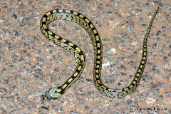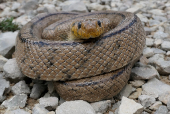|
Ladder Snake (Zamenis scalaris)
Description: The ladder snake is a medium-sized snake which reaches a maximum total length (including tail) of around 63 inches but which averages 47 inches. It has a pointed snout. As an adult the ladder snake is less variable than many related snake species, the basic colour goes from yellowish to dark brown, with two darker stripes running down the length of the body from neck to tail. It normally also has a dark stripe running from the rear of the eye to the angle of the jaw and sometime subtle, darker markings on the sides. The ventral side is pale, varying from a silvery-grey to whitish, with the occasional dark spot. The eye is dark. The juvenile snakes have lighter and brighter colouration, varying from yellow to light brown, with the characteristic “ladder” pattern picked out in black along the upperside. The pale underside has black markings which sometimes coalesce to cover the whole of the underside. As the snake ages these colours and patterns fade until the simpler adult pattern is left.
Habitat: This mainly crepuscular and nocturnal species can be found in sunny and stony Mediterranean-type habitats with good vegetation cover, including riparian habitats. It can also be found in open woodlands and shrubland, at field edges, hedges, vineyards, olive groves, overgrown areas, stone walls and ruins
Range: Introduced into Southern Florida. This species is found through much of Portugal and Spain (it is absent from much of northernmost Spain) and southern France. There is a record from northwestern Italy, but there is no recent confirmation of its occurrence in this country. It is present on the islands of Ons and Arousa in Galicia (Spain), Minorca (an old introduction) in the Balearic Islands (Spain), and Iles d'Hyères, France. The species ranges from sea level to 2,200 m asl.
Found in these States:
FL
Diet: Like other "rat snakes", the majority of the ladder snake’s prey is mammals such as mice, rabbits and shrews, making up 75% of prey items with a further quarter being spiders, insects (especially grasshoppers) and a few birds. To prey on birds the ladder snake will climb to search for active nests in trees or on man-made structures. Lizards are also eaten. Juvenile ladder snakes prefer small lizards, baby rodents, spiders, and grasshoppers.
Reproduction: The females lay between four and 15 eggs that are deposited under ground cover.
Status: Listed as Least Concern in view of its wide distribution, tolerance of a broad range of habitats, presumed large population, and because it is unlikely to be declining fast enough to qualify for listing in a more threatened category.
»» Kingdom: Animalia - Animals
»» Phylum: Chordata - Chordates
»» Subphylum: Vertebrata - Vertebrates
»» Class: Reptilia - Reptiles
»» Order: Squamata - Scaled Reptiles
»» Suborder: Serpentes
»» Superfamily: Colubroidea
»» Family: Colubridae - Colubrids
»» Genus: Zamenis
»» Species: Zamenis scalaris - Ladder Snake
This article uses material from the Wikipedia article "Ladder Snake", which is released under the Creative Commons Attribution-Share-Alike License 3.0. Content may have been omitted from the original, but no content has been changed or extended.
|
|













